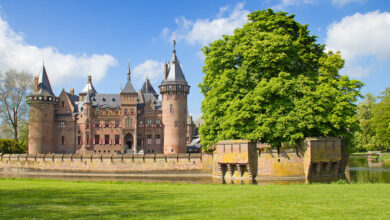
Fort bij Krommeniedijk: a hidden gem of Dutch military history
Nestled amidst the scenic polder landscape of North Holland, Fort bij Krommeniedijk is a fascinating example of Dutch military ingenuity and an essential part of the UNESCO-listed Defense Line of Amsterdam, also known as the Stelling van Amsterdam. Built between 1881 and 1886, this historic fort was once part of a complex network of fortifications designed to protect the city of Amsterdam. Today, it’s a peaceful haven, offering visitors a unique glimpse into the Netherlands’ strategic defenses and the natural beauty that has reclaimed the site.
A vital link in the Stelling van Amsterdam
The Defense Line of Amsterdam spans 135 kilometers and consists of 42 forts and numerous dikes, locks and canals, forming a ring around the city. This network was an innovative response to the country’s low-lying terrain and constant threat of invasion. The idea was simple but ingenious: by strategically flooding the polders surrounding Amsterdam to a depth of about 40 centimeters, the area would become too shallow for boats but too deep for troops on foot, creating a natural barrier against invaders.
Fort bij Krommeniedijk played a key role in this line of defense, guarding access routes into Amsterdam. However, by the time it was completed, advances in warfare, such as long-range artillery, had already rendered the fortifications somewhat obsolete. Despite this, the fort and its surrounding defenses served as a strategic deterrent and were garrisoned until World War II. Today, they stand as a testament to the Netherlands’ resilience and ingenuity in defending its land.
The fort’s architecture and layout
Fort bij Krommeniedijk, like other forts in the Defense Line, is built primarily of brick and concrete, designed to withstand artillery shelling. It has a distinctive, squat structure with thick walls, small windows and narrow gun slits, which allowed soldiers to observe and protect the surrounding area. The interior includes barracks, storage rooms and a central courtyard. The surrounding moat and nearby sluices were crucial to the flooding system, demonstrating how Dutch engineers integrated natural elements with defensive architecture.
Fort bij Krommeniedijk today
After its military decommissioning, Fort bij Krommeniedijk became a protected monument and today it’s open to the public, managed by various heritage organizations. The site is more than just a historical artifact; it has evolved into a haven for nature and wildlife. The wetlands around the fort attract a wide range of bird species, making it a great destination for birdwatchers and nature enthusiasts. Visitors can wander the serene trails that loop around the fort and explore the interior during open days or guided tours.
In October 2017, Fort bij Krommeniedijk began a new chapter as a thoughtfully repurposed community space. Extensive renovations transformed the fort into 25 residential units tailored for individuals with autism, as well as a unique experience center and on-site café. This reimagining was made possible through the combined efforts of De Heeren van Zorg, the Province of North Holland, Stadsherstel Amsterdam and Landschap Noord-Holland, who united in 2011 to breathe new life into the site. Now known as Fort K’IJK, the location also features a redesigned fort keeper’s house, crafted by designer Piet Hein Eek, blending historical charm with contemporary design.
A place for inspiration and reflection
Fort bij Krommeniedijk is more than just a relic of the past. The peaceful atmosphere offers a sense of escape and contemplation that contrasts with its martial history. Artists, history buffs and nature lovers alike will find something to appreciate at this tranquil site. The fort also hosts occasional art exhibits and events, using the historical backdrop to create an immersive experience that connects modern culture with historical heritage.
Planning your visit
Fort bij Krommeniedijk is accessible via Krommenie, a small town near Amsterdam. It’s an ideal day trip from the city, easily reached by car or bike. Check the fort’s website or local tourism boards for information on open days and tours, as the interior is not always open to the public.



